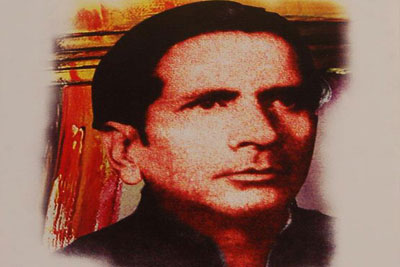 In Guru Dutt
In Guru Dutt's "Pyaasa", before that haunting Sahir Ludhianvi dirge on the arbitrariness of human relationships ("Jaane woh kaise log the...."), two Urdu poets are shown. For the current generation, they will just be the expected depiction - a gaunt man reciting a sonorous lyric and a bearded man in traditional garb declaiming in courtly style.
Aficionados - sadly, a shrinking number - will be able to name the duo on hearing the 'asha'ar' (plural of 'shers') they recite of the poets they are representing - Asrar ul-Haq 'Majaz Lakhnavi' and Ali Sikandar 'Jigar Moradabadi' respectively.
The names will, to a great majority of current Indians, ring only a faint bell. The only frame of reference that might work is that Majaz was the brother-in-law of another great poet, Jan Nisar Akhtar, and thus the maternal uncle of Javed Akhtar and the opening couplet from one of Jigar's ghazals gained immense popularity - but as a dialogue in Hindustani films - "Ham ko mita sake woh zamaane mein dam nahi..."
It is unfortunate that such literary figures are reduced to such obscurity - more so with Majaz (1911-55), who fits all tropes of a poet - extraordinary skill with words, verse and metre, a literary output which encompassed revolution as well as romance and popularity with both the literary elite and the masses.
He was also a pin-up star of his time, his skills of repartee and quips were legendary. He had an obsessive affair with a married woman, leading to his committal to a mental asylum when she refused to abandon her marriage, and his life ended in tragic circumstances - death of exposure on a cold December night after being left alone on the roof of a bar in Lucknow - while he was at the pinnacle of his creativity.
Majaz's ouevre, as mentioned, straddles both romantic and progressive thought. As an example of the first, take one of the couplets used in "Pyaasa", whose cadence and rhythm will strike even for those who cannot understand the language.
"Roodad-e-gham-ulfat un se kya kehte kyunkar kehte/Ik harf na niklaa hothon se aur ankh mein ansu aa bhi gaye".
This happens to be the fourth couplet from his 1933 ghazal, which begins "Taskeen-e-dil mahzoon na huyi voh saaye karam farmaa bhi gaye..." and goes on this way:
"Ham arz-e-vafaa bhi kar na sake kuch keh na sake kuch sun na sake/Yaan ham ne zabaan hi kholi thi vaan aankh jhuki sharma bhi gaye"
and
"Ashuftagi-o-vahshat ki kasam, hairat ki kasam, hasrat ki kasam/Ab aap kahen kuch ya na kahen ham raaz-e-tabassum pa bhi gaye"
On the other hand, Majaz is strident in his call for the artistic fraternity to not shrink from action when the coming revolution demands. In his nazm titled 'Inquilab', also of 1933, he declaims:
"Phaink de ae dost ab bhi phaink de apna rabab/Uthne hi wala hai koi dam mein shor-e-inquilab"
The work employs some stark imagery of what the tumult will entail.
"Koh-o-sehra mein zameen se khoon ublega abhi/Rang ke badle gulon se khoon tapkega abhi"
Majaz could use his art in other situations too. The nazm "Raat-o-Rail" is an account of a train journey at night, and while reading it, you feel you are on one yourself.
"Phir chali hai rail isteshan se lahraati huyi/Nim-shab ki khamoshi mein zer-e-lab gaati huyi/Dagmagaati, jhumatii, seeti bajaati, khelati/Vaadi-o-kohsar ki thandi hawaa khaati huyi"....
and on for another 37 couplets.
His most well-known work happens to be the nazm "Awaara", brought in mass public consciousness when two-three stanzas, slightly modified, were used as a song in the film "Thokar" (1953), picturised on Shammi Kapoor and rendered by the incomparable Talat Mehmood.
Inspired by a night-time walk on the Marine Drive in then Bombay, the rhythmic 'Awaara" captured the essence of alienation in a teeming metropolis.
"Shahr ki raat aur main nashad-o-nakaara hoon/Jagmagati jagti sadkon pe awaara phirun/Ghair ki basti hai kab tak dar-badar mara phirun/Ae gham-e-dil kya karun, ae vahshat-e-dil kya karun"
And its inspired imagery:
"Ye rupahli chhaaon ye akash par taaron ka jaal/Jaise Sufi ka tasavvur, jaise aashiq ka khayaal/Aah lekin kaun samjhe, kaun jaane dil kaa haal/Ae gham-e-dil kya...
But the best is: "Raaste mein ruk ke dam le lun meri aadat nahi/Laut kar wapas chala jaun meri fitart nahi/Aur koi hamnawa mil jaaye ye qismat nahi/Ae gham-e-dil kya...
Majaz figures in innumerable anecdotes. But the best one (for me) is when a mushaira he was in was disturbed by cries of an apparently hungry baby in the audience. Majaz rose and softly said: "Naqsh fariyaadi hai kis ki shokhi-e-tahreer ka (or roughly, "of whom is this applicant a copy" or in other words, who are the parents).
This happens to be the first line of Ghalib's first ghazal and only a thoroughly ingrained poet could have used it on the spur to fit the occasion. That was Majaz for you!
 In Guru Dutt's "Pyaasa", before that haunting Sahir Ludhianvi dirge on the arbitrariness of human relationships ("Jaane woh kaise log the...."), two Urdu poets are shown. For the current generation, they will just be the expected depiction - a gaunt man reciting a sonorous lyric and a bearded man in traditional garb declaiming in courtly style.
In Guru Dutt's "Pyaasa", before that haunting Sahir Ludhianvi dirge on the arbitrariness of human relationships ("Jaane woh kaise log the...."), two Urdu poets are shown. For the current generation, they will just be the expected depiction - a gaunt man reciting a sonorous lyric and a bearded man in traditional garb declaiming in courtly style.